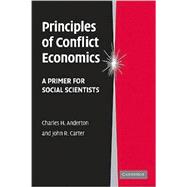
Note: Supplemental materials are not guaranteed with Rental or Used book purchases.
Purchase Benefits
What is included with this book?
| List of Figures | p. xi |
| List of Tables | p. xvii |
| Preface | p. xix |
| Introduction: Definition and Scope of Conflict Economics | p. 1 |
| What Is Conflict Economics? | p. 1 |
| A Look at Conflict Large and Small | p. 2 |
| Methodology of Conflict Economics | p. 10 |
| Organization of Book | p. 13 |
| Bibliographic Notes | p. 13 |
| Production Possibilities and the Guns versus Butter Trade-Off | p. 15 |
| Production Possibilities Model | p. 15 |
| Applications | p. 21 |
| Bibliographic Notes | p. 27 |
| Rational Choice and Equilibrium | p. 28 |
| Rational Choice Model | p. 28 |
| Supply, Demand, and Market Equilibrium | p. 43 |
| A Taxonomy of Goods | p. 50 |
| Bibliographic Notes | p. 52 |
| Fundamentals of Game Theory | p. 53 |
| Basic Concepts | p. 53 |
| Chicken and Prisoner's Dilemma Games | p. 59 |
| Repeated Prisoner's Dilemma | p. 63 |
| Bibliographic Notes | p. 66 |
| A Bargaining Model of Conflict | p. 67 |
| Elements of Conflict | p. 67 |
| Sources of Violent Conflict | p. 69 |
| Third-Party Intervention | p. 78 |
| Bibliographic Notes | p. 81 |
| Conflict between States | p. 83 |
| The Conflict Cycle | p. 83 |
| Patterns of Armed Interstate Conflict | p. 85 |
| Hirshleïfer's Bargaining Model and Interstate War | p. 87 |
| Selected Empirical Studies of Interstate Conflict | p. 92 |
| Bibliographic Notes | p. 101 |
| Civil War and Genocide | p. 104 |
| Definitions | p. 104 |
| Patterns of Armed Civil Conflict and Genocide | p. 105 |
| Theoretical Perspectives on Civil War | p. 113 |
| Selected Empirical Studies of Civil War and Genocide | p. 118 |
| Bibliographic Notes | p. 124 |
| Terrorism | p. 126 |
| Defining Terrorism | p. 126 |
| Patterns of Terrorism | p. 127 |
| A Rational Choice Model of Terrorism | p. 132 |
| Game Theoretic Perspectives of Terrorism | p. 139 |
| Selected Empirical Studies of Terrorism | p. 146 |
| Bibliographic Notes | p. 153 |
| Geography and Technology of Conflict | p. 155 |
| Boulding's Model of Spatial Conflict | p. 155 |
| O'Sullivan's Three-Dimensional Model of Spatial Conflict | p. 164 |
| Schelling's Inherent Propensity toward Peace or War | p. 168 |
| Number and Size of Nations | p. 174 |
| Selected Empirical Studies | p. 179 |
| Bibliographic Notes | p. 183 |
| Arms Rivalry, Proliferation, and Arms Control | p. 185 |
| Definitions | p. 185 |
| Patterns of Arms Rivalry, Proliferation, and Arms Control | p. 186 |
| The Richardson Arms Race Model | p. 197 |
| The Intriligator-Brito Model | p. 202 |
| An Economic Choice Model of Arms Rivalry | p. 210 |
| Selected Empirical Studies | p. 217 |
| Bibliographic Notes | p. 220 |
| Military Alliances | p. 222 |
| Definitions | p. 223 |
| Patterns of Interstate Alliances | p. 226 |
| Pure Public Good Model of Alliances | p. 229 |
| Joint Product Model of Alliances | p. 237 |
| Selected Empirical Studies | p. 240 |
| Bibliographic Notes | p. 244 |
| Conflict Success Functions and the Theory of Appropriation Possibilities | p. 246 |
| Conflict Success Functions | p. 246 |
| A Model of Appropriation Possibilities | p. 249 |
| Appropriation Possibilities in a Production/Exchange Economy | p. 256 |
| Bibliographic Notes | p. 267 |
| Statistical Methods | p. 269 |
| Populations and Samples | p. 269 |
| Probability and Sampling | p. 270 |
| Expected Values and Unbiased Estimators | p. 272 |
| Statistical Inference | p. 272 |
| Regression Analysis | p. 274 |
| A More Formal Bargaining Model of Conflict | p. 277 |
| Basic Model of Resource Conflict | p. 277 |
| Selected Sources of Violence | p. 280 |
| References | p. 285 |
| Author Index | p. 307 |
| Subject Index | p. 315 |
| Table of Contents provided by Ingram. All Rights Reserved. |
The New copy of this book will include any supplemental materials advertised. Please check the title of the book to determine if it should include any access cards, study guides, lab manuals, CDs, etc.
The Used, Rental and eBook copies of this book are not guaranteed to include any supplemental materials. Typically, only the book itself is included. This is true even if the title states it includes any access cards, study guides, lab manuals, CDs, etc.